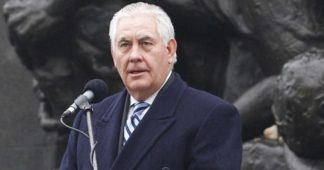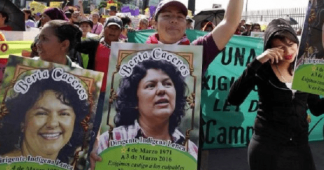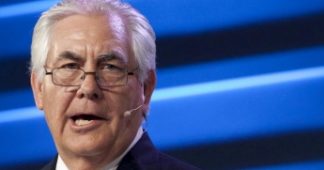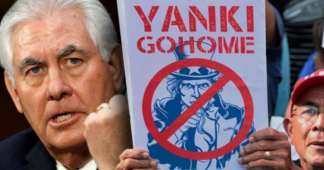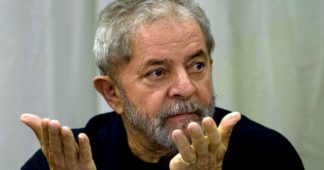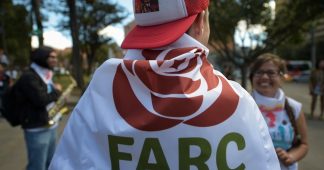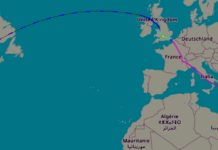US secretary of state Rex Tillerson is touring Latin America. His itinerary includes all the countries of Latin America and the Caribbean, as well as a visit with the leaders of five countries (Mexico, Argentina, Peru, Colombia, and Jamaica). The main practical agenda consists the fight against crime and narcotics, immigration, and the economy. However, this is also in many ways a symbolic move.
On the eve of the tour, Tillerson spoke at the University of Texas, after which he left for Mexico.
On the first of February, the secretary of state began his tour and is planning to visit Buenos Aires on the third, Peru on the fifth and sixth, and after that Colombia and Jamaica
An attempt to create a cohesive programme
As experts note, the US has tried earlier to rather directly build dialogues with individual countries when problems appeared (examples are Venezuela, Mexico, and Cuba). Tillerson is trying to construct a complete “Latin-American policy”.
The tour has several practical aims, hiding behind the ‘war on drugs’ and immigration agenda: turning the region against Cuba and Venezuela, especially against the government of Nicolas Maduro.
As experts say, the geopolitical signal is a clean-up of the US’ ‘backyard’ on American terms.
US interest in Mexico
Mexico, which is a painful subject for America, remains one of the main points of the Trump agenda. The day before, the president declared that he will construct a Wall on the Mexican border. Despite the fact that the level of migrants reached a record from 2001, every time a statement about the Wall is made tens of Mexicans cross the border.
The country is also of interest to the US because of the upcoming elections, which are currently dominated by the former head of Mejico-province Andres Manuel Lopez Obrador. The politician is against a re-evaluation of the North American Free Trade Agreement (NAFTA) and is also proposing a policy that is less dependent on the US. From Washington’s point of view, the Agreement must be re-evaluated because of ‘capital flight’ and is even threatening to leave the agreement. This is of serious concern to the Mexican government and is summoning threats in response, such as a refusal to support the US on the fight against drugs and the issue of illegal immigrants
Colombia
Columbia is of interest to the US as an ally in the war on drugs and a possible instrument of pressure on Venezuela. As far as internal affairs are concerned, then the coming presidential elections in 2018 and the new alignment of parties are of interest. An agreement between partisans of the Revolutionary Armed Forces of Columbia – People’s Army (now the official party FARC) and the government was reached, but negotiations with the insurrectionists (including members of the ‘National Liberation Army’ or ELN) are questionable.
If we also take socio-economic issues into account, we can say that the situation in Colombia is unstable and that this instability might be used by the US
Venezuela
One of the main US problems in the region are relations with Venezuela, especially with president Maduro. In his speech in Texas, Tillerson called upon the Venezuelan government to obey the country’s constitution and emphasised that Washington will pressure the Maduro regime for “democracy”. We should not forget, that in January 2018 the United States expanded their sanctions against Venezuelans. Now, restrictions also affect individuals, sanctions against the state oil company PVDSA, as well as Venezuelan government bonds.
A warning about Russia and China
An important emphasis in Tillerson’s Texas speech was placed on the “threat” posed by Russia and China in the Latin American region. The diplomat did not directly call Moscow and Beijing “potentially predatory forces, who are now appearing in our hemisphere”, but it was clearly insinuated that Russia and China are those same forces.
Further, the politician specified that growing Russian and Chinese influence in the region is disturbing Washington’s plans. Tillerson also thinks, that Chinese activities in Latin America resemble the “policy of colonial powers of the past” and that local states “do not need a new imperial power”
Relations between countries
However, the countries themselves are not particularly happy with the US. As the poll Latinobarometro (Chili) shows, Argentinian opinions of the US fell by 5% (from 56 to 49) between 2016; in Peru, the percentage dropped from 75 to 69, and in Mexico even fell from 77 to 48. After the first statements about the construction of the Wall and a harsh migration policy were made, we can observe a clear growth of anti-American sentiment in Mexico.
Therefore, the countries of Latin America themselves are not very much in agreement with their status of a ‘backyard’ and are moving more and more towards the idea of a multipolar world. Tillerson could not find common ground with his colleagues from the “Obama guard” for a long time, but the recent attempts to establish control over the region are clearly show jointly approved steps. The elections in several countries will be a stress test of those countries’ capacity to resist American influence under their new respective presidents.
Translated from the Russian by V.A.V.
Published at https://www.geopolitica.ru/en/agenda/tillersons-tour-latin-america-reminder-whos-boss
